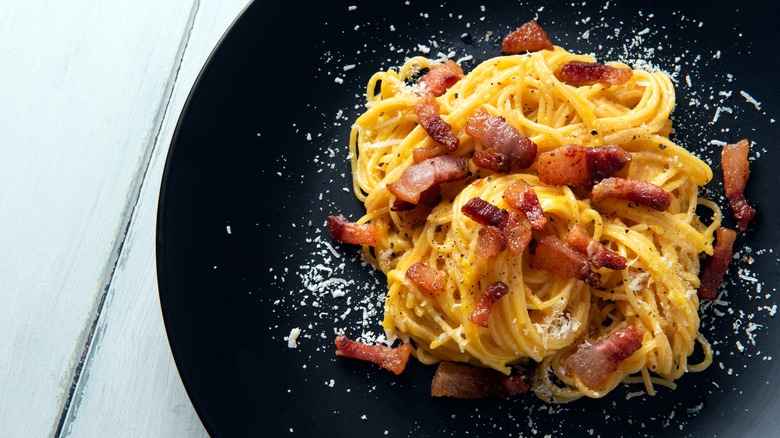Why You Shouldn't Use Bacon In Carbonara, According To The Pasta Queen
We may receive a commission on purchases made from links.
The Pasta Queen, known to family and fans as Nadia Caterina Munno, is hitting Amazon Prime with her new eponymous show, "The Pasta Queen." Focused on exploring the North, the Center, the South, and the islands of Italy, Munno dives into the culinary history of these four regions while teaching viewers how to cook like a real-deal Italian. In one episode, Munno focuses on her "Holy Trinity of Pasta Dishes," featuring carbonara, cacio e pepe, and Amatriciana — all from the Lazio region of Italy. For carbonara, she highlights the importance of using the correct meat.
"Never use bacon or pancetta for that matter. It's the wrong type of cured meat," Munno warns the viewer. According to Munno, guanciale is the only meat you should use for your carbonara. We're all for shirking tradition for ease, but there's a strong flavor reason why you might want to spring for the guanciale even if it takes a little extra effort and money. Guanciale comes from the jowl of the pig and contains more fat than bacon. Once that fat is rendered down, it goes straight into the sauce, infusing it with a sweet and savory flavor. Plus, bacon is typically only cured for a week or two, whereas guanciale is cured for up to three months, which adds to its overall richness.
Tips for cooking guanciale for your carbonara
The pork-of-it-all, guanciale, is a cured meat typically seasoned with salt, pepper, coriander, garlic, and rosemary. It not only provides a delightfully crispy texture to combat the creaminess of the egg and cheese, but the rendered-out fat is a crucial component to the sauce's signature silkiness. According to the Pasta Queen, before you cook your guanciale, you want to cut your pork strips on the thicker side and up to ¾ of an inch wide. Because the pork will shrink down in the heat, you want to be sure you still end up with those large, crispy texture-giving chunks of guanciale in your sauce.
The origin of carbonara is just as opaque as its creamy, meaty sauce — some people believe the dish comes from Roman charcoal makers due to having "carbone" in the name, which is Italian for charcoal. Others don't question its origins and just enjoy the simple perfection of its humble ingredients: egg, cheese, pasta, and pork. Regardless of who invented it, one thing is for certain, this Holy Trinity pasta dish has all of the ingredients for a forever foodie favorite.

